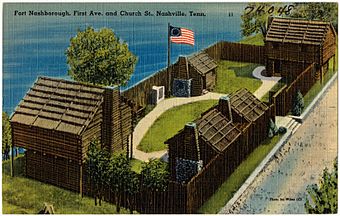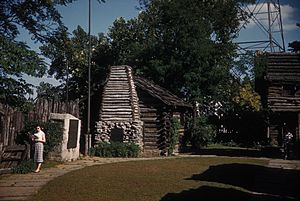Fort Nashborough facts for kids
|
Fort Nashborough
|
|
|
Formerly listed on the U.S. National Register of Historic Places
|
|

A historical reconstruction of Fort Nashborough
|
|
| Architect | North Carolina Militia (Overmountain Men) |
|---|---|
| Architectural style | log stockade |
| NRHP reference No. | 11000454 |
Quick facts for kids Significant dates |
|
| Added to NRHP | July 13, 2011 |
| Removed from NRHP | November 24, 2015 |
Fort Nashborough was a fort built in early 1779 near the Cumberland River in what was then called French Lick. This fort was the very beginning of the settlement that later grew into the city of Nashville, Tennessee. It was a large, square stockade made of logs, covering about 2 acres (8,100 square meters).
Inside the fort were 20 log cabins. It provided a safe place for early settlers, protecting them from wild animals and Native American groups. Today, you can visit a reconstructed version of Fort Nashborough near its original spot. It is managed by Nashville Parks and Recreation.
Contents
Why Fort Nashborough Was Built
The American Revolution started shortly after Richard Henderson made a land deal with the Cherokee people. This deal was for a large area of land meant for a new settlement called Transylvania.
Many Cherokee towns wanted to stay out of the fight between the colonists and Britain. However, Chief Dragging Canoe saw the war as a chance to stop settlers from taking more Cherokee lands. American attacks on his Cherokee towns in eastern Tennessee eventually forced Dragging Canoe and his people to move.
They moved south and west along the Tennessee River. By 1779, they settled near Chickamauga Creek (close to modern-day Chattanooga, Tennessee). These people became known as the Chickamauga Cherokee. Dragging Canoe had warned that any white settlers moving into the Cumberland River valley would "pay a heavy price." He kept his promise.
Planning the New Settlement
Before Fort Nashborough, no one had tried to build a permanent town at French Lick on the Cumberland River. In 1779, John Buchanan Sr. and his family traveled from Pennsylvania to North Carolina. They first went to a safer area in Virginia to leave the women and children.
Then, the settlers moved down the Cumberland River. In early 1779, they built a strong station at French Lick, which would later be called Fort Nashborough.
Leaders and Land Deals
In February 1779, Overmountain leader James Robertson explored the same area with nine men. Robertson had been a leader in the Watauga Association settlement. He helped arrange a land deal for 3,000 acres (12 square kilometers) with Richard Henderson.
The settlers agreed to pay Henderson 26 pounds of silver for every hundred acres. This was considered a very high price at the time. Robertson left three men behind to plant corn, preparing for a much larger group to arrive.
Robertson then traveled to the Illinois Country, which Virginia claimed at the time. He met General George Rogers Clark, a land agent for Virginia. Clark was offering land titles on good terms. Robertson wanted to make sure the new Cumberland River settlement would have clear land ownership. After making plans with General Clark, Robertson got ready to lead more settlers to the Cumberland area.
The Journey to Fort Nashborough
The journey to the new settlement was difficult, with two main groups traveling separately.
Robertson's Overland Journey
On November 1, 1779, James Robertson led about 200 settlers from Fort Patrick Henry in Kingsport, Tennessee. This group traveled by land towards Fort Nashborough. Their job was to prepare for the women and children who would arrive later by river.
Robertson's brothers, Mark and John, and his 11-year-old son, Jonathan, were part of this group. They were joined by John Rains and his friends. This group decided to settle at French Lick. Their journey ended on Christmas Day, but it was delayed by the coldest winter anyone had ever known.
Donelson's River Journey
John Donelson led the second group, which started their river journey in early 1780. They were stopped after only three miles because the river froze due to ice, snow, and cold. They couldn't move again until mid-February. Even then, heavy rains caused the river to swell, making progress hard.
Donelson's group also faced attacks from Dragging Canoe's warriors. As they traveled down the Tennessee River past the Chickamauga towns, they were attacked. Near the Tennessee River's "Big Bend," the warriors captured one boat with 28 people.
On March 20, 1780, they reached the mouth of the Tennessee River. They were tired, hungry, and low on supplies. Their boats were built for floating downstream, so going upstream against the strong current of the Ohio River was very hard. Some people decided to leave the group and settle elsewhere.
However, others were determined to continue up the Ohio River to the Cumberland River. They were unsure if it was the Cumberland at first because it seemed smaller than expected. But they decided to go upstream and soon realized they were right. Donelson even rigged a small sail on his boat, the Adventure, to help them move faster.
Establishing the Settlement
When Donelson's group finally arrived, they reunited with Robertson. The settlers cleared the land and built their new home. They named the settlement in honor of General Francis Nash, a hero of the American Revolution.
These brave pioneers also built other fortified "stations" nearby. These included Eaton's Station, Clover Bottom Mansion, Freeland's Station, Mansker's Station, Thompson's Station, and Buchanan's Station. Many of these names are still used for neighborhoods or towns in the Nashville area today.
Early Government and Life
James Robertson helped create a set of rules called the Cumberland Compact. This document helped the new settlement govern itself, giving it some independence from North Carolina.
Life at the Fort
The forests around the fort were full of wildlife. There were buffalo, black bears, wild turkeys, deer, beaver, raccoons, foxes, elk, wolves, cougars, mink, and otters. Settlers relied on their guns for hunting, axes for cutting wood, and seeds and hoes for farming. Life on the frontier was a constant challenge, and these tools were essential for survival.
Corn was the most important crop for their daily meals. Corn was also used to make a drink that was thought to help with health problems. For the first winter, Richard Henderson even arranged for corn to be shipped from Kentucky, though it was very expensive. Clothes were made from linen (from flax) or cotton, and animal skins were also used.
The first white child born in the new settlement was James Robertson's son, Felix, on January 11, 1781. He later became a very important doctor.
In 1783, the Land Grab Act offered land in 100-acre (0.4 square kilometer) plots for about five dollars. Much land was given to people who had served honorably in the military. However, some land that was reserved for Native Americans was also claimed, leading to disputes.
Native American Attacks
The Cherokee were the largest tribes in the region. While they had been peaceful with eastern British colonists, the Cumberland settlement faced constant attacks from the beginning. The tribes were angry about broken treaties and settlers moving onto their hunting grounds.
The Chickasaw tribe decided to make peace with the Cumberland settlers. Piomingo, an important Chickasaw leader, believed the pioneers were less of a threat than the Spanish government.
However, Dragging Canoe's Cherokee warriors and their Muscogee allies continued to attack the frontier settlements for the next fourteen years. The settlers always had to be ready for attacks. On April 2, 1781, Dragging Canoe's Chickamauga Cherokee attacked the fort.
In this attack, known as the "Battle of the Bluffs," the warriors tricked most of the men into leaving the fort. Then, they tried to cut them off from returning. But the settlers managed to escape back inside. The fort's dogs, released by the women, also helped. After this, the attacks became less frequent the following year.
The Battle of Fort Nashborough (also called Battle of the Bluff) was fought between the North Carolina militia and the Chickamauga Cherokees on April 2-3, 1781, at this fort.
Fort Nashborough Today
A smaller copy of Fort Nashborough was built in the 1930s in Downtown Nashville. It was made from old telephone poles as part of a government project to create jobs during the Great Depression. The replica has been repaired and updated many times since then.
For a while, the fort was open for self-guided tours during the day. However, it was badly damaged in the 2010 Tennessee flood and was closed. There were plans to tear it down and build a memorial plaza instead.
But on July 13, 2017, a ceremony was held for the newly renovated Fort Nashborough History Center. Now, families from Nashville and around the world can visit to learn about Nashville's history. The new History Center tells a more complete story of the past, and it includes a special plaza dedicated to Native American history.




